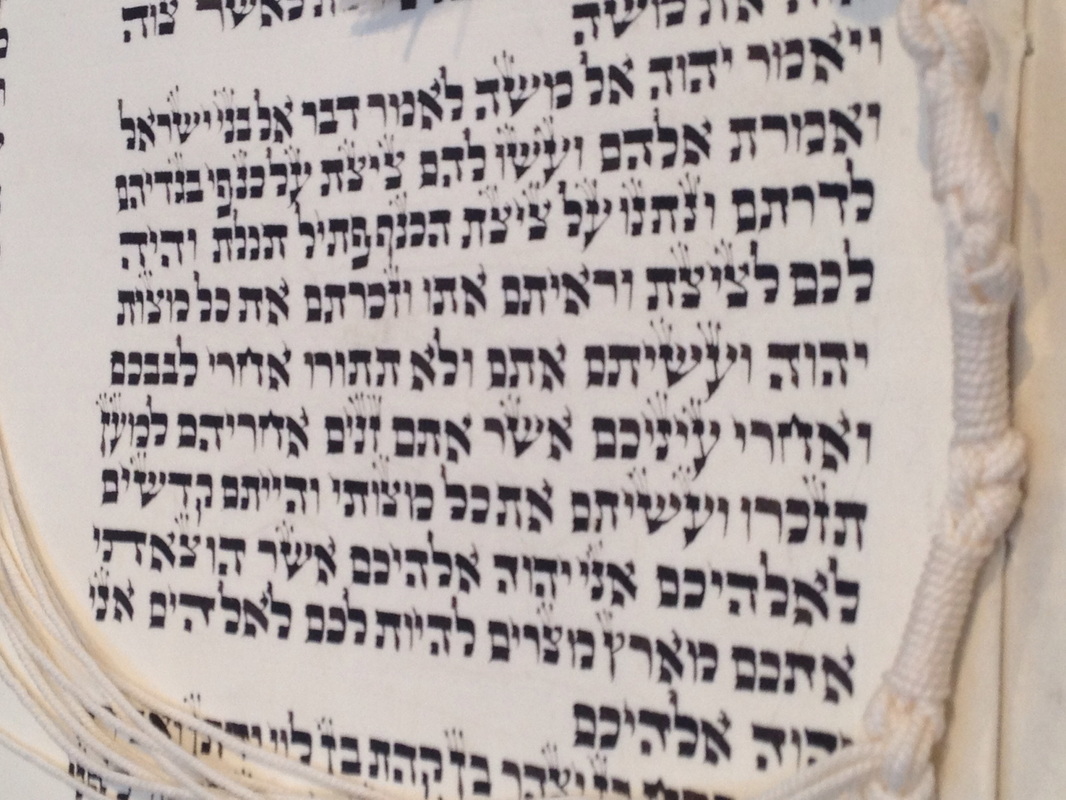| One of my earliest Jewish memories is sitting next to my grandfather in synagogue, playing with the fringes of his tallit. The tallit, or prayer shawl, is traditionally worn by adult Jewish men during morning worship. In many liberal Jewish communities, where both men and women may wear a tallit, there is a tradition of presenting a first tallit to the bar or bat mitzvah at the beginning of the service. My grandfather gave me the tallit I wore when I became a bar mitzvah. |
(For many years, Reform prayerbooks omitted the verses that refer to tzitzit, ostensibly because most Reform Jews did not wear a tallit. In recent decades, wearing the tallit has become common in Reform congregations and the most recent Reform prayerbook, Mishkan T'filah, restores the passage as an option in the morning service.)
I never paid much attention to the actual method for wrapping and knotting the strands of the tzitzit until, about three years ago, when one of the tzitzit broke on my favorite tallit. I purchased a set of tzitzit strings (available from most Jewish book stores) and taught myself how to tie them.
According to the tradition followed by most Ashkenazic Jews, there are four sets of wrappings separated by five pairs of knots on each tzitzit. There are seven wrappings between the first set of knots, eight wrappings between the next set, eleven between the next set, and thirteen between the last. It looks like this:
There is also gematria that shows how the tzitzit correspond to the mitzvot, the 613 commandments given in the Torah. The word "tzitzit" itself has the numeric value of 600 (when spelled with two yuds). Add to that, the eight strands and the five knots on each tzitzit and, presto, you have the number 613. Wearing a tallit symbolizes acceptance of the obligation to do mitzvot.
The connection between the tzitzit and the mitzvot is not incidental. In a passage from this week's Torah portion, we read, "Adonai told Moses, 'Tell the Israelites to make tzitzit on the corners of their garments in every generation…They shall look at it and remember all of Adonai's mitzvot and do them'" (Numbers 15:38-39).
When a Jew puts on a tallit to pray in the morning, he or she recites a blessing that acknowledges the commandment "to wrap oneself in tzitzit." Metaphorically, we wrap ourselves in the mitzvot. The mitzvot are not just orders issued to us from above. Rather, they are the spiritual clothes that we wear. They protect us, adorn us, and reflect the inner beauty of our souls with the outer beauty of our actions.
We also recite a verse before putting on the tallit that declares that "God…is clothed in splendor and majesty, wrapped in light as a garment, unfolding the heavens like a curtain" (Psalm 104:1-2). God also wears a tallit, a garment of light that represents the heavens.
Today, when I put on my tallit, I think about my grandfather. I also remember how the tallit recalls a partnership with God that makes us and our actions central to the order of the cosmos. I think about how, when we perform mitzvot, we are doing our joyful part in creating the world of our dreams—a dream that we dream together with God.
Other Posts on This Topic:
Shelach Lecha: Getting Up Close and Personal
Yoga and Judaism: The Yoke's on You
Joy and Obligation



 RSS Feed
RSS Feed
